Pashmina is the regal art of handcrafting luxury apparel and wraps from a rare wool type. The wool is acquired from an exotic goat of the Ladakh region and is called Cashmere. It is cashmere that is processed in a number of steps to make these luxe apparel and accessories that are spread across the world for patrons to cherish. Pashmina shawls are, and for centuries have been recognized as the most delicate, warm, soft, and smooth wraps in the world. It is believed that each thread used to make a Pashmina shawl is 5 times finer than human hair.
Cashmere or Pashmina: What is the difference?
If you do not know the difference between Cashmere and Pashmina, do not consider yourself alone. Almost half of the population who owns Pashmina does not! This confusion occurs because even sellers do not make it clear to customers. Vendors tend to deceive customers and sell anything in the name of Pashmina or Cashmere. But the basic difference between Cashmere and Pashmina is very basic
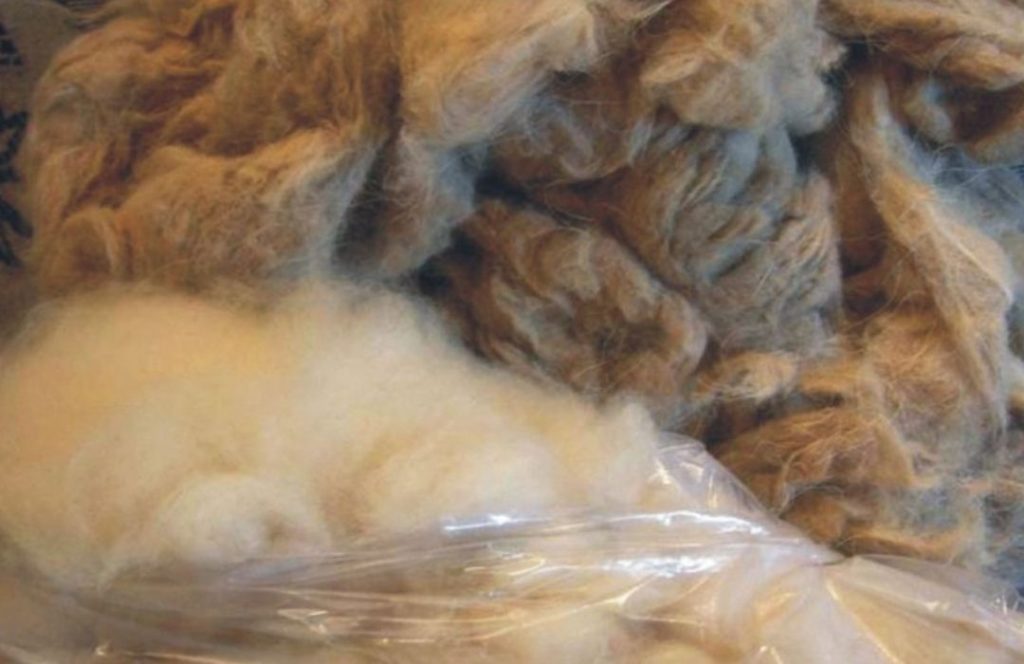
Cashmere is the raw wool that is collected from the Ladakhi goat and spun to fine yarn. Pashmina is the art of transforming this fine wool into precious shawls, scarves, wraps, and apparel. Cashmere was a term coined by Europeans who came to Kashmir to purchase Pashmina shawls in bulk. Cashmere is an anglicized word for ‘Kashmir’. On the contrary, Pashmina comes from the word ‘Pashm’, which translates to ‘soft gold’ in the Persian language.
History of Pashmina
It was almost the 15th century when a Persian saint traveled to Ladakh. It was he who observed for the first time an extremely light and fine wool growing on the body of a Ladakhi goat. He noticed that this wool has the strength to keep a person warm, even in the harshest of winters in Ladakh. He realized how valuable this wool could be, and ordered socks to be made from this. These luxuriously soft and warm socks were gifted to Kashmiri king Zain ul Abideen.
The king was so impressed with the fine quality of the socks that he ordered craftsmen to be invited from Persia. These artisans were immensely skilled and trained the locals in the weaving of the newly discovered Cashmere wool. Shah E Hamdan, the discoverer of Cashmere wool suggested that Cashmere should be woven into shawls and wraps, as Kashmir was a place where winters were harsh and long, and summers were short and pleasant.
Because the founder of Pashmina was from Persia, it was called Pashmina (from the Persian word Pashm). Not only the nomenclature but embroidery patterns chosen for Pashmina shawls, too, were influenced by Persian designs.
The Famed Shawls of Kashmir
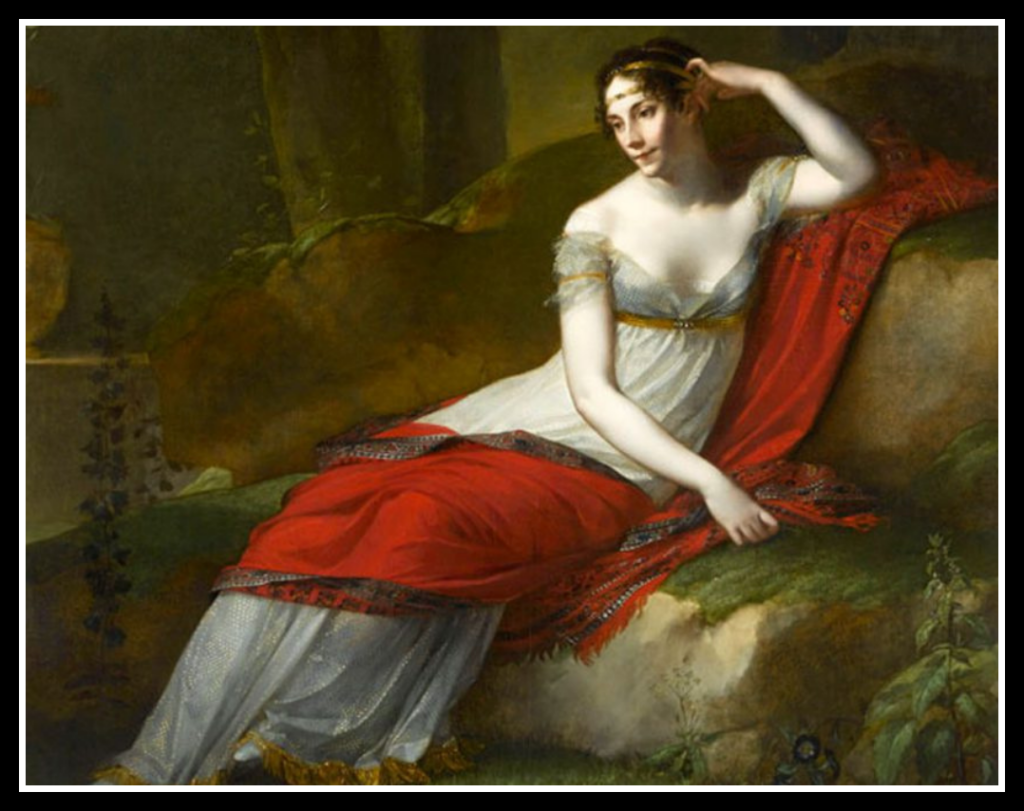
It was the 18th century when Napoleon was returning from a campaign to Egypt when he encountered a person owning a Pashmina shawl. He loved the quality and looks of the shawl so much that he gifted one to his wife Empress Josephine. She too was allured by the same, and later ordered about 400 Kani Pashmina shawls. And since she was considered a fashion icon of her time, her looks inspired other noble and affluent women to invest in the same. This gave more impetus to Pashmina sales, and in turn to the local Kashmiri economy.
Europeans, especially the French, tried to grow and make their own Pashmina shawls, but never could they manufacture something as soft, fine, and warm as the original pure Cashmere Pashmina shawls of Kashmir. They tried sheep wool and wool from other breeds of Cashmere goats, but Ladakhi goats’ Cashmere wool was indeed unparalleled in terms of finesse, warmth, and softness.
Be it locally, or globally, Pashmina shawls were a sign of status and wealth. Women from the royal courts were the only ones who could afford and hence own Pashmina shawls. It was either purchased by kings and queens, or gifted to someone of the same status, and social class.
Fake shawls - introduction of the power loom
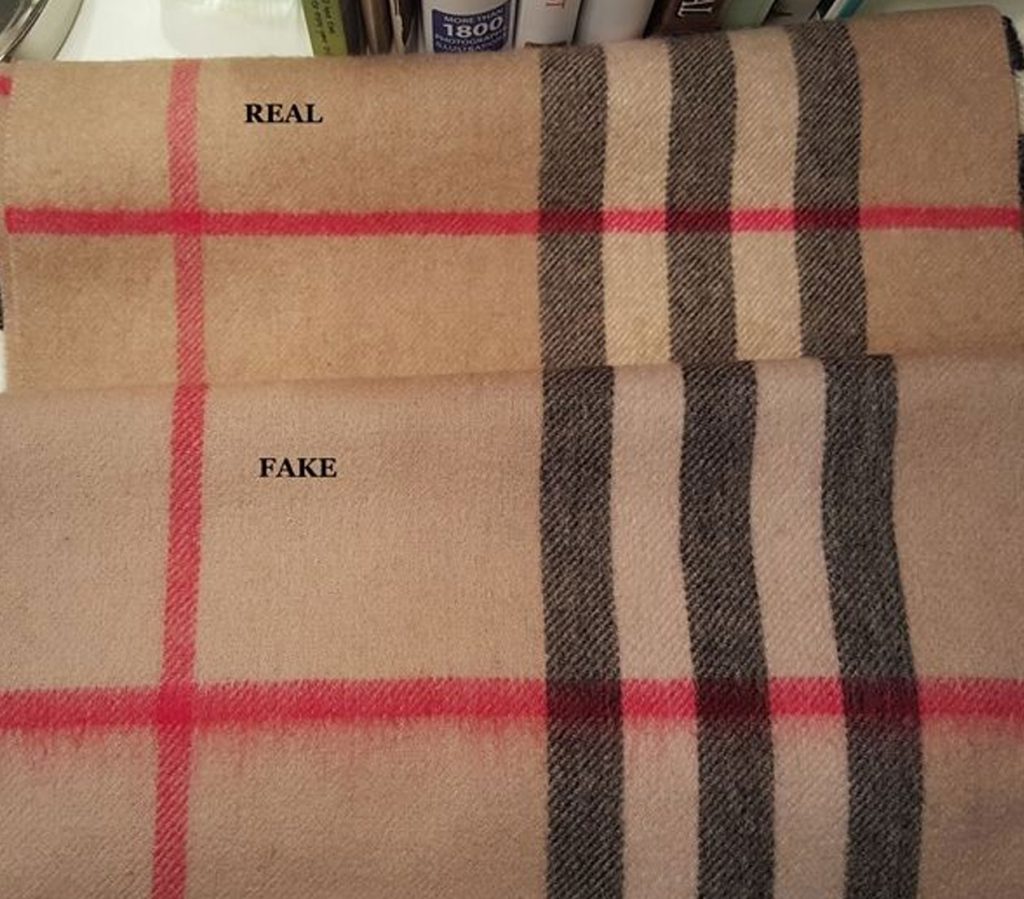
When Pashmina shawls began to be treated like a treasure, some money-desirable individuals introduced machines in the spinning and weaving of Cashmere. Cashmere is delicate and needs to be processed manually, which takes a lot of time. But since these wealth-craving people needed quick money, they used machines and got their profits quickly. And since these fake shawls were cheap because of being made from just 70% or 60% Cashmere, their sales were high. It was only after they withered in a few years, that customers realized they had been fooled. This tarnished the image of the art, and people stopped buying Pashmina shawls.
The Geographical Indication GI
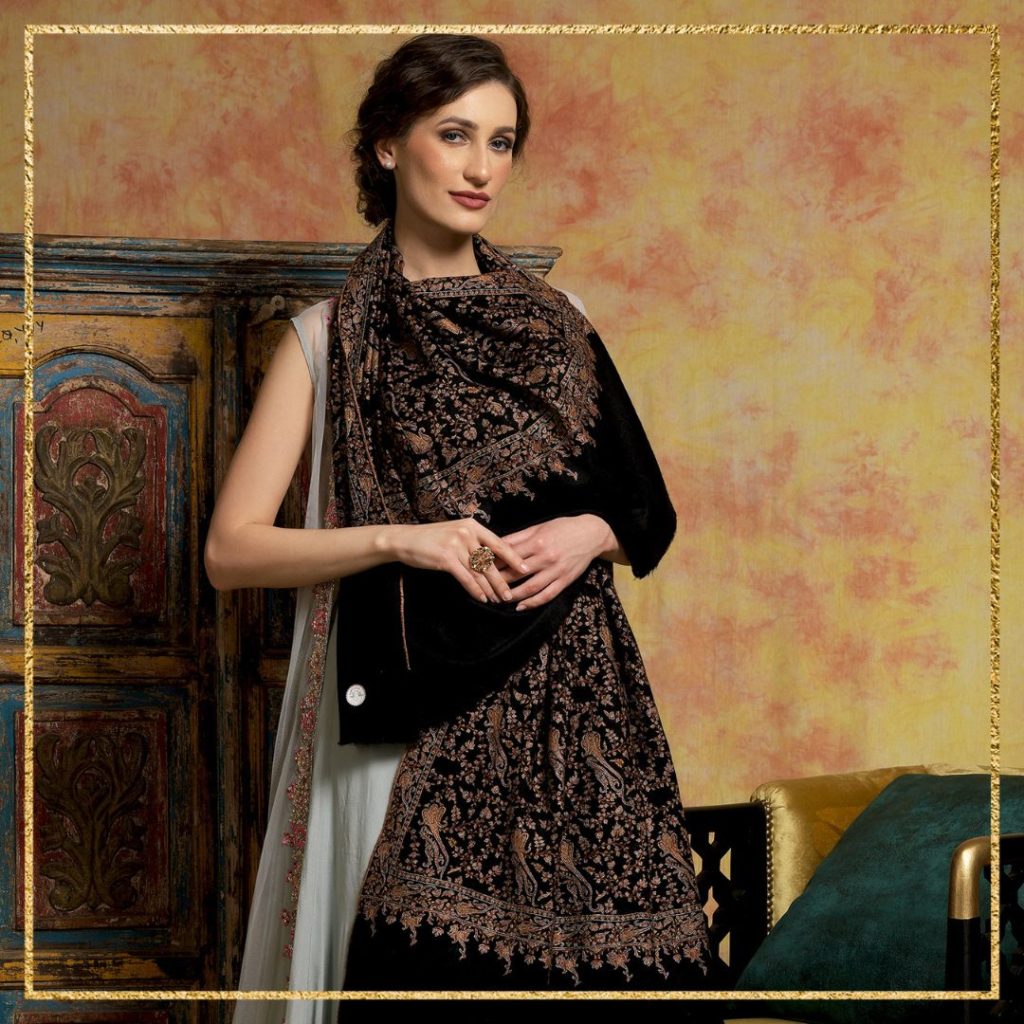
To conserve the traditional art of spinning and weaving pure Cashmere and to maintain international standards, the Government of India (Under WTO) has established a quality mark for original Pashmina. This will help identify pure Pashmina items, made from Cashmere obtained from Ladakh. The geographical Indication (GI) Label on Kashmir Pashmina is a US patent stamp on the original ‘Kashmir Pashmina’. It is called the GI mark, and shawls with this mark are called GI pashmina shawls. The GI mark and shawl purity are discussed later in detail
The GI mark is differentiated purely from fake Pashmina shawls. GI Pashmina shawls take much time to complete, but once done, they look like living art pieces. To know about how fascinating the real art of Pashmina is, we discuss in depth the making of a pure Pashmina before it is stamped with the GI mark.
Changthang - the home of the Changthangi goat
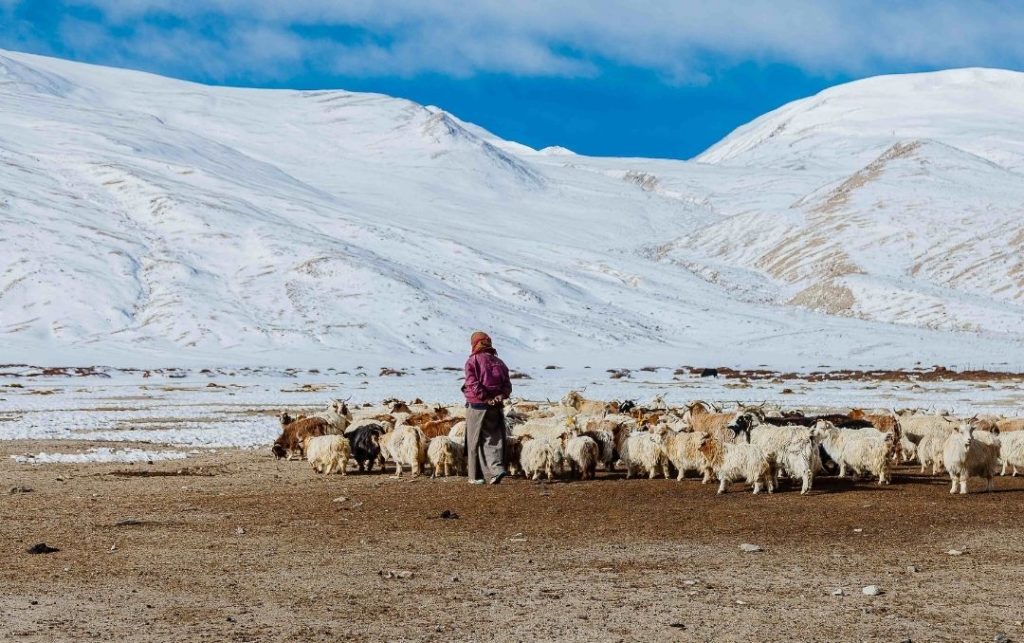
Ladakh is located on the Northeast side of Kashmir valley. It is home to Buddhists and a nomadic population who survive in fairly difficult conditions. It is these Ladakhi goats and a few breeds of sheep that this population survives on. The goats are found in the Changthang region of Ladakh.
Changthangi goats or Ladakhi goats are also called Pashmina goats. The goats grow an outer layer of fleece called an overcoat. It is coarse and thick. The second layer is grown under this outer coat and is called the down coat. The down coat is fine and fibrous. It is this down coat that protects them from the harsh winter that the area experiences. Winter temperature at Ladakh is -40 degrees C, and Cashmere saves the goat from its harm. Just When summer is about to begin, the goat naturally sheds this undercoat, which is collected by its herders. This is raw Cashmere, still to be cleaned and sorted.
Acquisition of Cashmere
Pashmina shawls are made from Cashmere, which is really difficult to procure. It has to be managed from the lower layer of the Ladakhi goat, which grows as an undercoat. This is the reason why Cashmere wool has to be sorted post-acquisition from Ladakh, as guard hair is found mixed with it. Cashmere is the shorter and finer hair and grows on the underbelly and neck area of the goat.
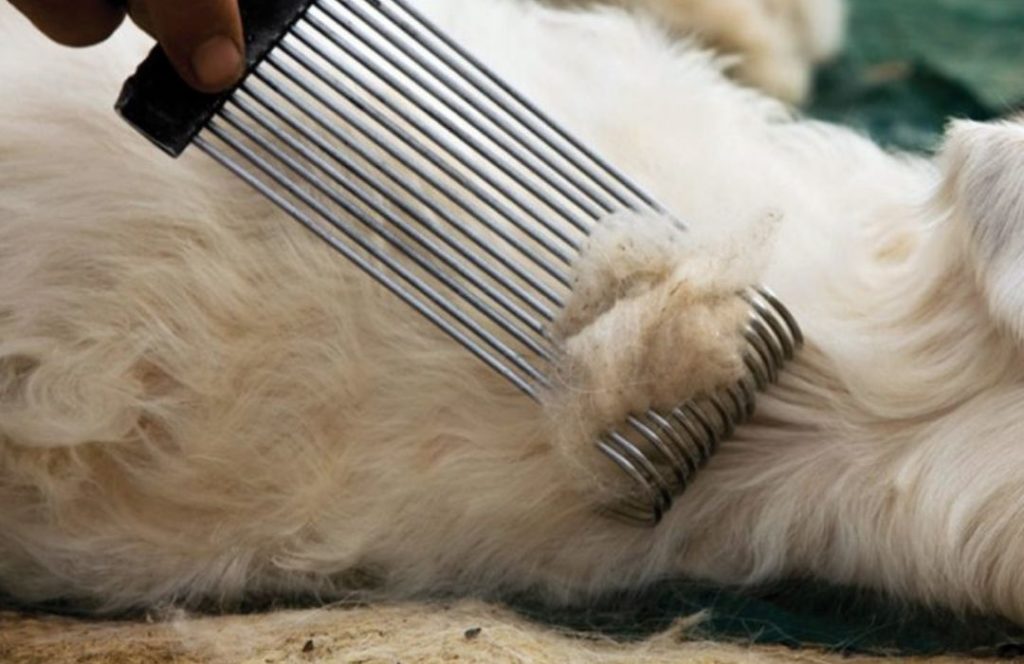
As Spring season arrives the goat naturally sheds this coat. Come summers, the goats are fairly uncomfortable, as the wool makes them warm and uneasy. Herders assist them and gently comb out a portion of their bodies, leaving them free of this ‘burden’. No mechanical help is required for this process, as machines would tear the fibre. Hence large toothed combs and hands are used. Even though the process is time-consuming, but this is the only option, as shearing or plucking would be animal cruelty.
This wool is cleaned and filled in small packs. Then these packs are sold to middlemen, who in turn sell them to the womenfolk of Kashmir. That is it from Ladakh. Now Pashmina moves to Kashmir permanently.
Processing of Cashmere
The processing of Cashmere and transforming it into Pashmina shawls required mastery of the craft and immense knowledge about all the steps. It is not something that a newbie can try. It is like a family tradition. Families which are known to be associated with the art of Pashmina making are the people who have taken the skill from their parents or grandparents. Each member of a family is responsible for each step in the process. Pashmina is a generation-old art and needs thorough practice and learning. Most processing units are located in the main city of Kashmir.
The Cashmere wool is in the shape of a lump when it arrives in Kashmir. As such, it is cleaned thoroughly first and then dipped in rice water. The starch of rice adds strength to the fibres and makes them durable. Post cleaning, the fibre is now sent for spinning. The women, responsible for spinning Cashmere, start with segregation based on quality. They then start spinning only the finest threads. Spinning wheels are used to spin Cashmere, and transform them into fine yarn. This process required immense patience and decades of experience and expertise, as a small wrong movement of the hand can easily tear the delicate fibre.
Fine yarn is again washed in rice water. Post this, it can be dyed if it needs to. The person who dyes Cashmere fibre boils it in copper pots which are filled with natural dyes. These are later dried, awaiting the next step - Weaving.
Pashmina Weaving
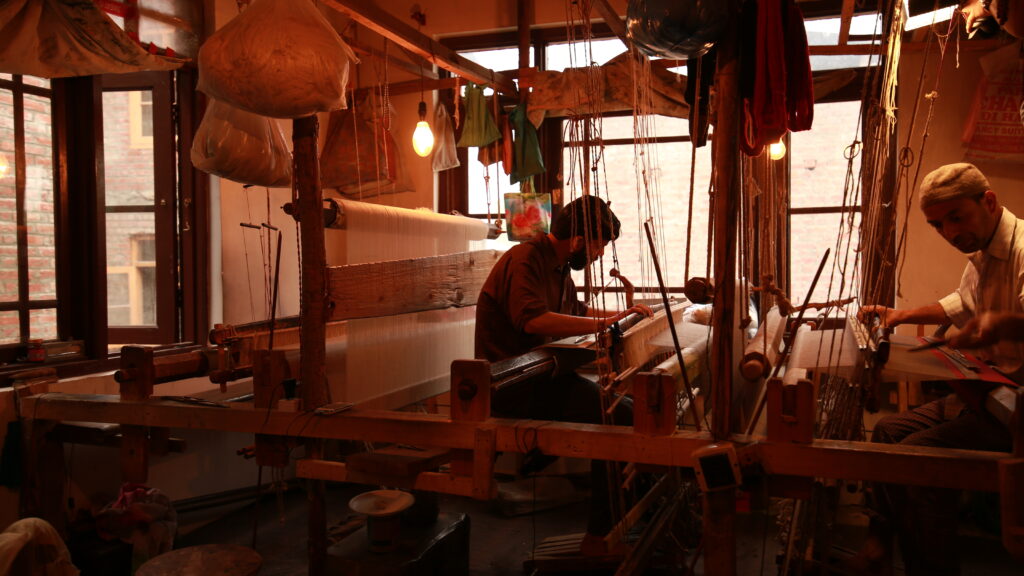
Warps and Wefts of Cashmere fibre are dressed around a traditional wooden handloom. One or two weavers sit on opposite sides of the loom and weave the fibre for a period of 3 to 4 days. It is after these days that yarn has been fully converted into a shawl. This is the Kashmiri Pashmina shawl. Foreign threads are cut off and fringes are shaped post-weaving. Weaving is done by the men of a family.
Post-weaving, the shawl is washed in spring water, directly flowing from mountains. It is believed that the minerals deposited in this water add lustre to the shawl. The shawls are then dried, and steam ironed in a roller, before packing them in beautiful packaging and selling them in markets.
Also read: IS CASHMERE WARM?
Embroidery or patterning a Pashmina shawl
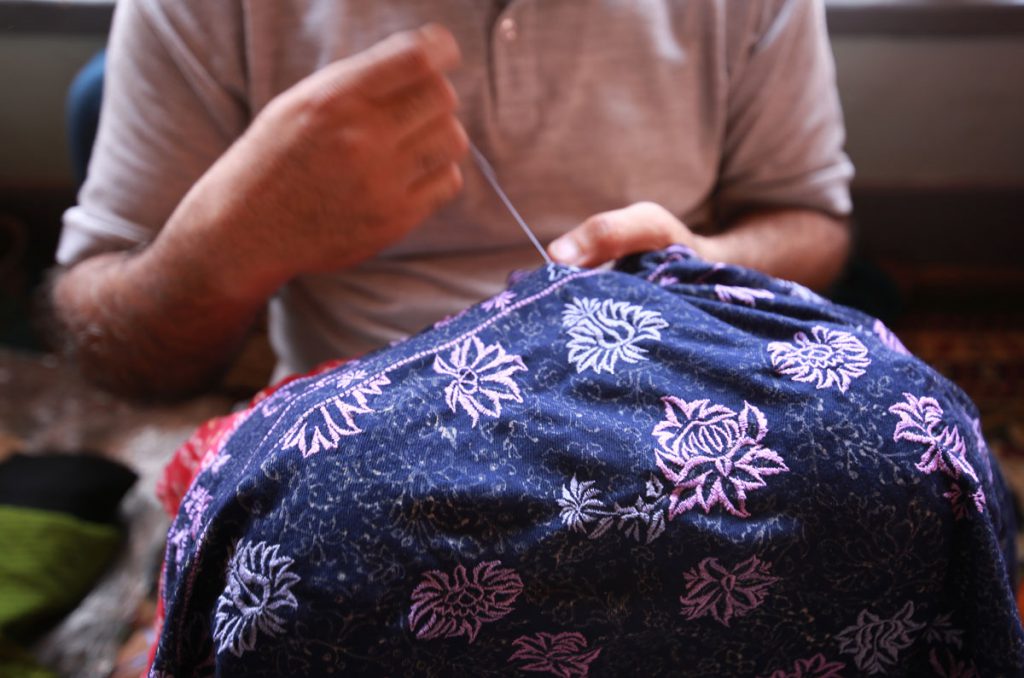
A shawl is either plain or full of designs. Designs can be embroidery, Kani weave, reversible weave, or more contemporary like prints, patterns, laced, and ombre dyed pieces. Pashmina shawls cater to every age, gender, and taste. Modern designs are preferred for everyday use, while traditional embroidery or Kani shawls are chosen for weddings or special occasions. It is traditional heavy shawls that take years to complete.
Also read: ART OF PASHMINA - EMBROIDERED PASHMINA STYLE
Why are Pashmina shawls considered special?
Since its discovery, Pashmina shawls have had a major impact on society. For several reasons, these shawls hold a special place in the hearts of Kashmiri people, especially women. Here are several impacts that Pashmina shawls had on the locals:
- Women empowerment: For the first time, the women of Kashmir began to earn when they learnt the skill of spinning Cashmere threads. According to historians, it was only Kashmiri women who had the skill of spinning such fine wool and still managed to maintain the structure and purity of the fibre. Along with earning them livelihood, Pashmina making brought them immense respect from locals and this uplifted their status in the community.
- Betterment of the Economy: As shawls from Ladakh began to be imported by foreign countries, especially from Europe, it gave an impetus to the local economy. It even improved the relations between India and these countries, as trade flourished more than expected. Not only Kashmir, but Ladakh’s local economy, too, improved much.
- Tourism: the largest source of income of Kashmir became its tourism industry, as foreign currency poured in. Tourists visited to see Pashmina shawls, and instead got lost in the scenic beauty and picturesque landscapes of this heaven on earth. This continued and still continues to take place. Tourists still spend a lot on crafty items and Pashmina shawls top this list.
The Geographical Indication (GI)
World Intellectual Property Organisation (WIPO) defines GI as follows:
“A geographical indication (GI) is a sign used on products that have a specific geographical origin and possess qualities or a reputation that are due to that origin. In order to function as a GI, a sign must identify a product as originating in a given place. In addition, the qualities, characteristics, or reputation of the product should be essentially due to the place of origin. Since the qualities depend on the geographical place of production, there is a clear link between the product and its original place of production. A geographical indication right enables those who have the right to use the indication to prevent its use by a third party whose product does not conform to the applicable standards.”
The sign is used on certain special products which belong to a specific geographical location or origin. It is a certification that the specific product possesses some unique qualities which are not found anywhere else and that it is made as per traditional methods, or has a certain reputation, due to its native origin.
Pashmina and the GI mark

Pashmina has been a certified GI product of Kashmir since 2008. To identify a pure Kashmiri Pashmina Shawl, a label has been developed by the Craft Development Institute (CDI) in union with Tahafuz ( a society dedicated to artisan welfare) and Govt. of India to recognize Handspun & Handwoven Pashmina. The label contains a non-copyable numerical code which can be verified online on their official website.
To pass the GI test, a Pashmina shawl should have the following features:
- Fibre should be obtained from Ladakh and should have a diameter of less than 16 microns.
- The shawl should be handspun using traditional technique
- The shawl should be handwoven over traditional handloom
The aim of the Kashmir Pashmina GI Label
- Identify genuine Pashmina Shawls
- Approve their originality and purity to the customers/buyers.
- Secure the livelihood of the artisan community, as many of them are widows.
- Promote and support indigenous art and craft.
Pure Pashmina Shawls
When shopping for a Pashmina shawl, some things should be kept in mind. First, the shawl should be purchased from an authentic vendor, someone who is in this business for a long time, and of whom a large number of customers approve. Second, the shawl should have a GI certification stamp on it. This guarantees a 100% pure Pashmina shawl. And third, if not the above two, the seller should at least be able to present the authentication certificate with the GI Pashmina shawl. These certificates are issued by the Craft Development Institute (CDI), Srinagar, which tests Pashmina shawls and issues certificates for pure lots.
If you already own a Pashmina shawl, and now doubt its purity, there are several tests to be conducted on them.
- The burn test, where you burn a fringe taken from the shawl, and check if it gives a natural hair smell upon burning.
- The weave test, where you check the weave of the shawl against a light source, and an uneven weave testifies its handwoven nature.
- Its matte presence is because natural hair doesn't have any shine to it.
- The pure shawl does not produce static electricity on rubbing. That is the quality of synthetic fibres.
- Lab tests done on Pashmina shawls show that the micron count of their fibre is 12-16 microns. If it's over this scale, do not buy it.
The Pashmina Ring test
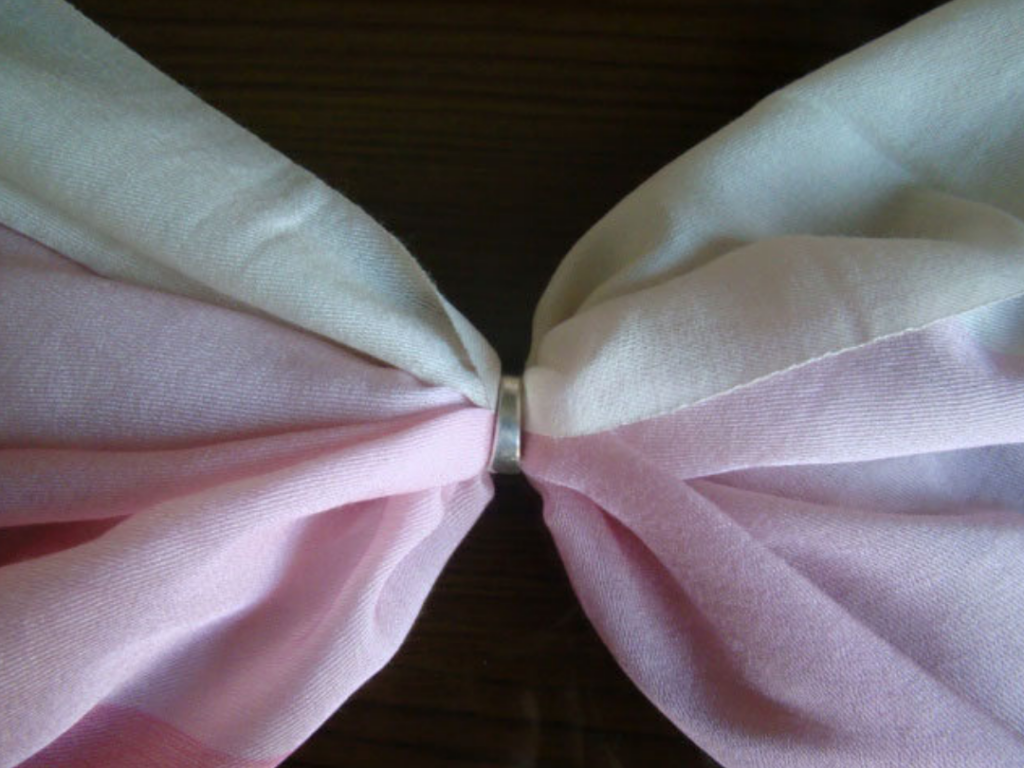
Several vendors might cheat you with this popular test, which has been deemed to be fake years ago. What happens is that vendors of Pashmina shawls pass the entire shawl through a finger ring. They do it to fascinate customers with the sheer softness and smooth texture of a Pashmina. This is indeed an amazing quality, but unfortunately, this does not prove a shawl is made from pure Cashmere. Many sheep wool shawls, treated with fabric softeners, pass a finger ring too! In fact, many shawls, whose fiber is mixed with nylon or silk pass through finger rings more easily! Hence this test might showcase the softness of a shawl, it definitely is no test for a Pashmina.
If one ever buys a Pashmina shawl, he/she should make it a point that the shawl is authentic. After all, Pashmina is not just purchased, it is invested in. A long-term investment like a Pashmina shawl should not go waste. After all, it lasts for an entire lifetime. But only if it is in its purest form. GI-certified Pashmina shawls are pure and original and last for even 30 years if properly taken care of. It is a luxury to own, a heritage to move forward, and one's culture that he should own with pride and pleasure.
Also read: HANDMADE PASHMINA VS MACHINE MADE PASHMINA - THE DIFFERENCE